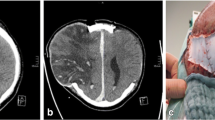Abstract
Introduction
The use of decompressive craniectomy in children is controversial and often reserved for patients with refractory intracranial hypertension. Following decompression, skin closure in select cases can be challenging due to brain herniation and swelling through the craniectomy defect. In these cases, partial cortical debridement is sometimes performed.
Methods
We describe two cases in which a synthetic skin substitute was used to facilitate a tension-free closure, rather than performing a partial lobectomy.
Results
At 6-month follow-up, both patients are at preoperative cognitive baseline, with some residual hemiparesis.
Discussion
We believe that use of a synthetic skin substitute for skin closure after decompression is a suitable option for closure of traumatic scalp wounds and may contribute to improved functional outcome in patients with severe intraoperative brain swelling.



Similar content being viewed by others
References
Aboelatta YA, Aly HM (2013) Free tissue transfer and replantation in pediatric patients: technical feasibility and outcome in a series of 28 patients. J Hand Microsurg 5:74–80
Adil Abbas Khan M, Chipp E, Hardwicke J, Srinivasan K, Shaw S, Rayatt S (2010) The use of dermal regeneration template (Integra) for reconstruction of a large full-thickness scalp and calvarial defect with exposed dura. J Plast Reconstr Aesthet Surg 63:2168–2171
Akutsu N, Aihara H, Sakurai A, Kusaka J, Yasuda M, Kohmura E (2013) New technique of decompressive skinplasty with artificial dermis for severe brain swelling. Nerol Med Chir (Tokyo) 53:56–60
Brown M, Pourtaheri N, Katira K, Manjila S, Totonchi AS (2017) Local coverage for acute severely herniated brain using scalp and forehead flaps in a pediatric patient with head trauma. The Journal of Craniofacial Surgery 28:231–235
Doerfler A, Forsting M, Reith W, Staff C, Heiland S, Schäbitz WR (1996) Decompressive craniectomy in a rat model of malignant cerebral hemispheric stroke: experimental support for an aggressive therapeutic approach. J Neurosurg 85:853–859
Gaab MR, Rittierodt M, Lorenz M, Heissler HE (1990) Traumatic brain swelling and operative decompression: a prospective investigation. Acta Neurochir Suppl 51:326–328
Goedemans T, van derVeer O, Verbaan D, Bot M, LequinMB CBA et al (2018) Skin augmentation as a last-resort operative technique during decompressive craniectomy. World Neurosurgery 119:e417–e428
Gonyon DL Jr, Zenn MR (2003) Simple approach to the radiated scalp wound using INTEGRA skin substitute. Ann Plast Surg 50:315e20
Gower DJ, Lee KS, McWhorter JM (1988) Role of subtemporal decompression in severe closed head injury. Neurosurgery 90:187–196
Grassner L, Marhold F, Yousif M, Grillhösl A, Ungersboeck K, Schulz J, Strowitzki M (2019) Experiences with a temporary synthetic skin substitute after decompressive craniectomy: a retrospective two-center analysis. Acta Neurochir 161:493–499
Khashab ME, Rhee ST, Pierce SD, Khashab YE, Nejat F, Fried A (2009) Management of large scalp and skull defects in a severe case of Adams-Oliver syndrome. J Neurosurg Pediatr 4:523e7
Koenen W, Goerdt S, Faulhaber J (2008) Removal of the outer table of the skull for reconstruction of full-thickness scalp defects with a dermal regeneration template. Dermatol Surg 34:357e63
Merlino G, Carlucci S (2015) Role of systematic scalp expansion before cranioplasty in patients with craniectomy defects. J Craniomaxillofac Surg 43:1416–1421
Momoh AO, Lypka MA, Echo A, Rizvi M, Klebuc M, Friedman JD (2009) Reconstruction of full thickness calvarial defect: a role for artificial dermis. Ann Plast Surg 62:656e9
Rutigliano D, Egnor MR, Priebe CJ, McCormack JE, Strong N, Scriven RJ (2006) Decompressive craniectomy in pediatric patients with traumatic brain injury with intractable elevated intracranial pressure. J Pediatr Surg 41:83–87
Schwab S, Junger E, Spranger M, Dörfler A, Albert F, Steiner HH et al (1997) Craniectomy: an aggressive treatment approach in severe encephalitis. Neurology 48:412–417
Tufaro AP, Buck DW 2nd, Fischer AC (2007) The use of artificial dermis in the reconstruction of oncologic surgical defects. Plast Reconstr Surg 120:638e46
Yannas IV, Burke JF, Orgill DP, Skrabut EM (1982) Wound tissue can utilize a polymeric template to synthesize a functional extension of skin. Science 215:174e6
Yeong EK, Huang HF, Chen YB, Chen MT (2006) The use of artificial dermis for reconstruction of full-thickness scalp burn involving the calvaria. Burns 32:375e9
Yildirim S, Calikapan GT, Akoz T (2008) Reconstructive microsurgery in pediatric population—a series of 25 patients. Microsurgery 28:99–107
Author information
Authors and Affiliations
Corresponding author
Ethics declarations
Conflict of interest
On behalf of all authors, the corresponding author states that there is no conflict of interest.
Additional information
Publisher’s note
Springer Nature remains neutral with regard to jurisdictional claims in published maps and institutional affiliations.
Rights and permissions
About this article
Cite this article
Cooper, J.B., Kim, M.G., Mohan, A. et al. Decompressive craniectomy with scalp expansion graft using a temporary synthetic skin substitute in the pediatric population: case series and review of the literature. Childs Nerv Syst 36, 1319–1324 (2020). https://doi.org/10.1007/s00381-019-04494-5
Received:
Accepted:
Published:
Issue Date:
DOI: https://doi.org/10.1007/s00381-019-04494-5




